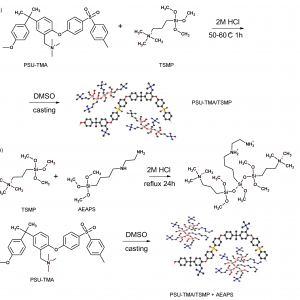Abstract
Nanocomposite anion exchange membranes were synthesized based on poly(sulfone trimethylammonium) chloride. A hybrid semi-interpenetrating silica network containing a large amount of quaternary ammonium groups was prepared by two sol–gel routes, in situ with a single precursor, N-trimethoxysilylpropyl-N,N,N-trimethylammonium chloride (TMSP), or ex situ mixing two precursors, TMSP and 3-(2-aminoethylamino)propyldimethoxy-methylsilane (AEAPS). The properties of these hybrid composites and their degradation after immersion in 1 M KOH at 60 °C were studied. The degradation is reduced in the composite materials with a lower decrease in the ion exchange capacity. FTIR spectra showed that a main degradation mechanism with a single precursor TMSP is the dissolution of the hybrid silica network in KOH, whereas it is stable with the mixture of TMSP/AEASP. This conclusion is in agreement with the thermogravimetric analysis. The mechanical properties show a better ductility with a single precursor and higher stiffness and strength, but less ductility, by the ex situ route. The activation energy was between 0.25 and 0.14 eV for Cl and OH ion conduction, respectively, consistent with the migration mechanism
Illustrations
Details
Published on: Membranes, 2021, 11(4), 260
Authors: E. Sgreccia, M. L. Di Vona, S. Antonaroli, G. Ercolani, M. Sette, L. Pasquini, P. Knauth
